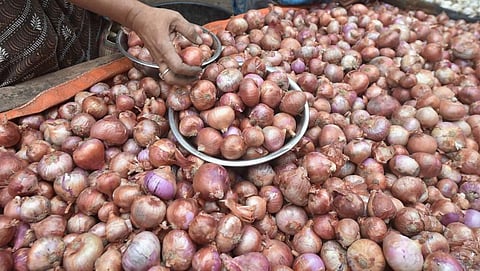

MUMBAI/BENGAlURU: There is little buzz in Nashik’s Lasalgaon, though it is Asia’s largest onion market. For, the mandi is shut as traders are protesting against Income Tax raids on 14 of them as also the ‘mindless’ stock limit imposed by the Central government.
Activity at Lasalgaon matters as a whopping 35% of India’s onion supply chain is sourced from that mandi.
Sulking traders are adding to the stress the kitchen staple is already facing because of heavy rains damaging the standing crop, pushing the average retail price across the country to around Rs 90 per kg (see box).
Retail prices in Telangana are particularly swollen (Hyderabad Rs 130-150; Warangal Rs 100-120; Karimnagar Rs 100) as supplies from Maharashtra are just a trickle.
Caught between the government and the trading community is the aam aadmi, who is being forced to reduce his onion intake.
“Many people have stopped buying the king of the kitchen for now,” revealed vegetable trader Pritam Das in Jaipur.
Till about a few days ago when Lasalgaon was a beehive of activity, onion arrivals were in the range of 70,000 to 75,000 tonnes per day as against the normal of 1.25 lakh to 1.50 lakh tonnes. In other words, a drop of 40-50%, informed Nanasaheb Patil, an onion growing farmer leader in Nasik.
“Lasalgaon gets ample supplies in August from states like Karnataka, Andhra Pradesh and Telangana after harvest. But this year, the standing crop in all the three states was damaged by the rains. In the first week of October, onions normally start arriving into the mandi from Maharashtra, Gujarat and Madhya Pradesh. But floods in parts of Maharashtra damaged both the old stock and fresh crops. As a result, new arrivals have been delayed by 40-60 days,” Patil shared.
In Karnataka, extended monsoon in Chitradurga, Ballari, Gadag, Dharwad, Haveri and Chikkamagaluru districts contributed to the super spike in prices.
“Although normally there is spike in onion prices in November-December because the March stocks tend to get exhausted and the October harvest cannot be dried and stored for long, this year’s rise is because around 70,000 hectares in Karnataka got affected by the monsoon,” said B N Prasad, managing director of Horticultural Producers’ Cooperative Marketing and Processing Society).
Soaring onion prices leave traders, household in ‘tears’
In Karnataka’s Chitradurga, its Nayakanahatti region produces export quality onion. “But this year a purple blotch disease attributed to heavy showers led to bulb rot,” said Nulenuru T Shankarappa, a farmer. Going forward, farmers are now again sowing onion seeds in the region.
“Since it is a three-month crop, we can expect some good produce by January-end,” he added while keeping his fingers crossed. Another bee in the wholesale traders’ bonnet is the stock limit of 25 metric tonnes imposed recently by the Centre to cool down prices.
“For big traders like me this limit is ridiculously low. As we cannot do business in such an environment, I have decided not to participate in the auctioning at Lasalgaon,” said a trader requesting anonymity.
Raids on 14 Lasangaon traders to force them to fall in line and reduce onion prices added to the drama.
“We are in a Catch 22 situation,” said Suvarna Jagtap, chairman of the Lasalgaon mandi.
“On the one side farmers are desperate to sell their summer stock but on the other, traders do not want to lift them because of the Centre’s policies. This will damage the farmers and consumer will end up paying high prices,” she feared.
Rashi Gupta, who lives in Jaipur’s Jawahar Nagar colony said “We are now cutting down on the use of onions as we have already suffered due to lockdown. But our home budget has gone bust due to spike in onion prices.
Even potato and tomato prices are soaring. For a middle class family like ours, which runs on a limited income, there is no option but to reduce buying of these vegetables.” Indeed.
(With inputs from our bureaux in Hyderabad, Vijayawada, Bhubaneswar, Chennai, T’puram, Jaipur, Srinagar, Patna, Kolkata, Lucknow, Chandigarh and Bhopal)